
Help yourself to our creative, hands-on activity ideas for teaching The Hobbit. We've been teaching children's literature in experiential ways since 2010, and we'd love to help you engage and inspire YOUR kids!
It's astounding how much they'll learn while they're "just" having fun!
When kids get to do things the characters did, they GET IT. With a little guidance, they know why that experience matters. They understand its role in the story, and what secret meaning it has. They see that literature is clever and cool. They get how fun great books are—and they want to read more.
Read on for:
Creative Teaching Ideas
Prep Tips & Printables
FAQ & Support
Learning Links
Our activities are perfect for homeschoolers, co-ops, classrooms, libraries, book clubs, and families.
for use with some of the activity ideas on this page
for teaching The Hobbit by J.R.R. Tolkien
LitWits makes a small commission (at no extra cost to you) on supplies or books you buy through our Amazon affiliate links.
Creative Teaching Idea #1
A table of objects pulled “straight from the story” can lead to all sorts of wonderful discussions and wide-eyed, “aha!” moments. Throughout your teaching experience of The Hobbit , pause to discuss and/or pass around relevant props. Items unique to the setting help kids understand “what that was like,” and those symbolic of themes help kids literally grasp big ideas.
Roäc the Raven
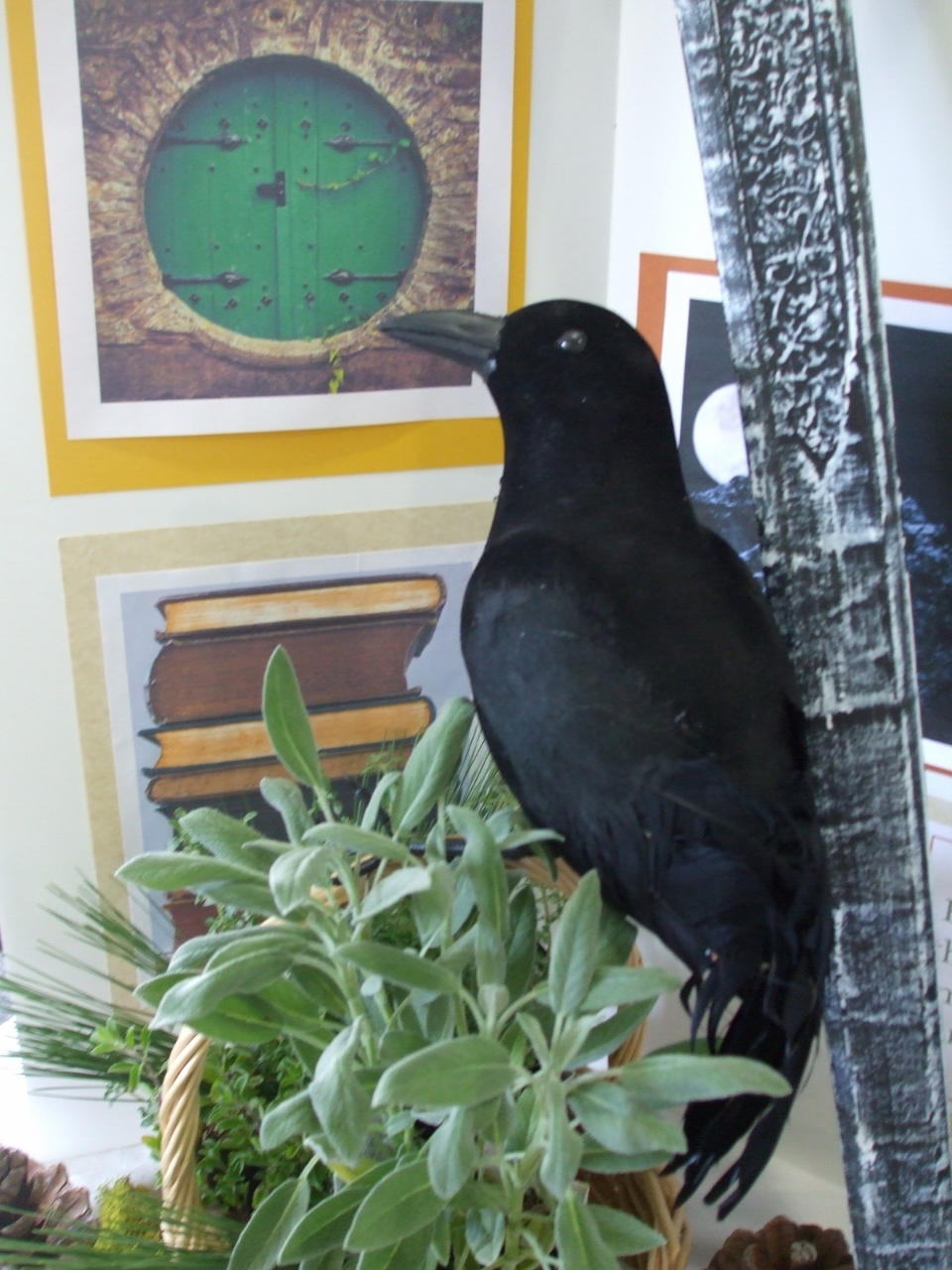
Though he's 153 years old and nearly blind, it's the great Roäc, son of Crac and chief of the ravens, who brings the dwarves the wonderful news that Smaug is dead. (Ch. 15). Having Roäc's descendant do some teaching will mesmerize your kids.
Herbs
As Gandalf, Bilbo, and the dwarves head further away from the goblin cave, the mountains become more barren. Shrubs, weeds, and rockroses disappear, as do the marjoram, sage, and thyme that had been part of the sweet-smelling scenery. (Ch. 6) Get your fresh herbs at the grocery store or nursery, but tell the kids you foraged on a mountain in Middle Earth.
Pine cones
After the travelers scramble up into trees and are surrounded by Wargs, Gandalf picks a few pine cones, sets one on fire, and throws it down to create the mayhem that attracts the attention of the Lord of the Eagles. (Ch. 6) If you can partially burn one in a fireplace, the kids might even believe you were on the scene.
Smaug's hoard
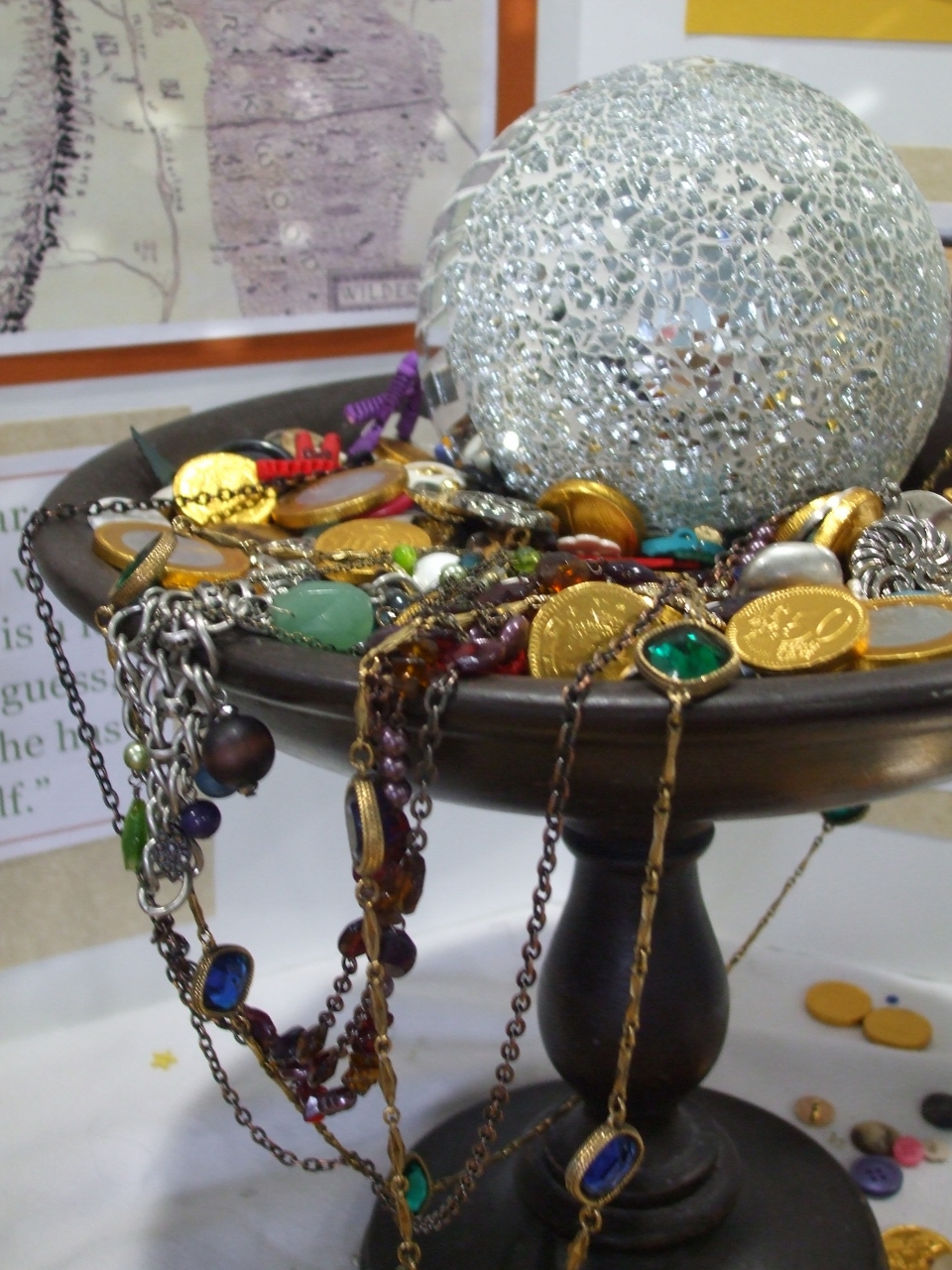
After Bilbo does “the bravest thing he ever did” and goes down the tunnel to face Smaug, he's awed by both the huge beast and his immense hoard of jewels and precious metals. (Ch. 12). To recreate the hoard, amass antique-looking bronze and colorful wooden buttons, some costume jewelry, and gold-wrapped chocolate coins.
The Arkenstone
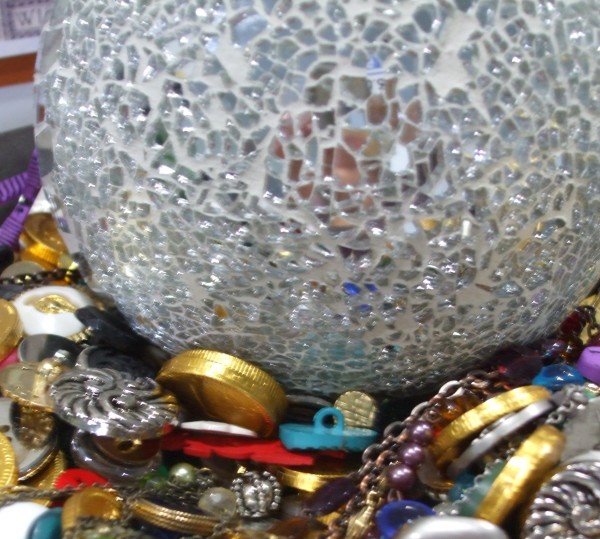
While fantasizing about the dragon’s hoard, Thorin remembers the lost Arkenstone of Thrain, a great shining sphere. His fervent description of the gorgeous gem is a passage well worth taking the time to read aloud! (Ch. 12) Ours was a garden ornament from a thrift store, but we exalted it. In fact, we put it on a pedestal! Here's a pedestal more worthy of Thrain's prize.
The Ring

When Bilbo finds The Ring on the floor of the goblin tunnel, he doesn’t yet realize that it’s a magical object that can make him invisible—and that will change his life forever. He simply puts it in his pocket without much thought. (Ch. 5) Tell the kids you found this one in your pocket this morning and not to worry if you disappear for a few minutes. Or days.
Pipe and "tobacco"
Bilbo's story begins with him smoking a pipe just before Gandalf arrives, and ends, years later, with him passing the wizard a tobacco jar. (Ch. 1, Ch. 19). To symbolize these "book-ends," we borrowed a pipe, substituting toasted shredded coconut for tobacco. Another aromatic symbol of companionable indulgence would be fresh coffee grounds. Either way, this unhealthy habit of our heroes means you'll want to explain that "back then they didn't know smoking is bad for you."
Goblin blood
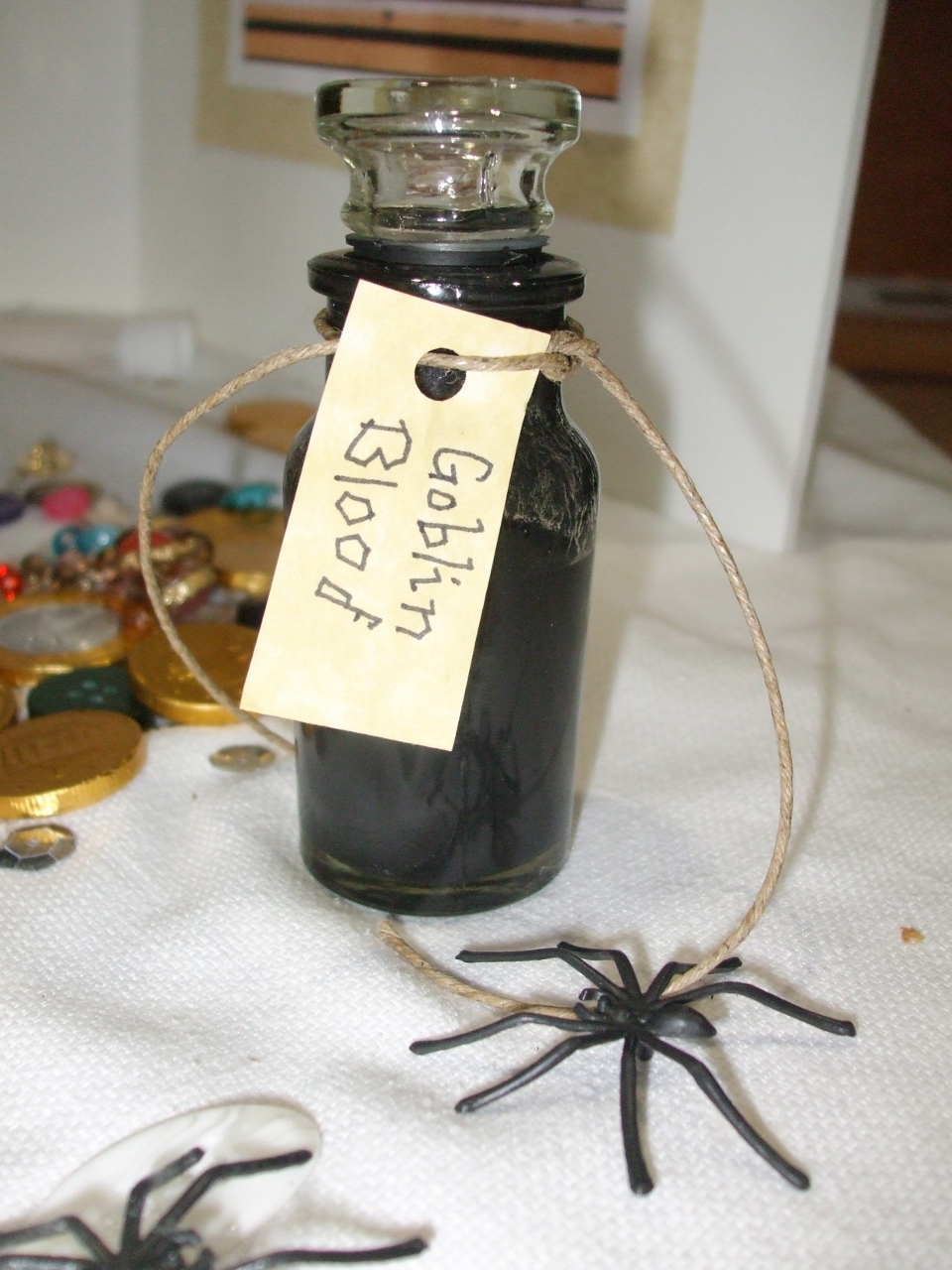
The elves begin the Battle of Five Armies by sending a multitude of arrows at their hated foes, the goblins. As the arrows find their mark the landscape becomes soaked with black blood. (Ch. 17) A small vial of goblin blood is the only relic of that gruesome battle. It's also used in our textural arc activity, so the goblins did not die for nothing. You can draw blood from any cooperative goblin, or from a more amiable bottle of washable black paint.
Elvish blade
We don't like to focus on weaponry, but there's no denying that Gandalf's sword, and the two swords found in the Troll's cave, along with Bilbo's dagger, all came in... handy. Whether you call your sword Glamdring, Orcrist, or an oversize version of Sting, you'll have tangibly made this . . . point. And if it starts to glow blue, you'll know just what to do.
Shelob's descendant
Two of the most spine-chilling scenes in this book are those involving spiders that wrap Bilbo up "to save for later." These scenes, both of which prove his developing skills and courage, along with J.R.R. Tolkien's great fear of arachnids, make a giant black (FAKE) spider a necessary prop. This one is bigger and hairier than ours was, and it can clamp onto someone's back, which is fun if the someone isn't you. Watch your back.
Beorn's feast

Food provided by the shape-shifter Beorn makes a bountiful display that symbolizes protection and providence, as well as a healthy snack. (For details, see the activity "Enjoy Beorn's feast-to-go without going.")
Creative Teaching Idea #2
We think it's important to know where your books have come from. After all, without the author, we wouldn't have The Hobbit ! This activity introduces your kids to J.R.R. Tolkien through a short video, and lets them practice some note-taking, too.
Photo: Wikimedia
Have your kids watch this 5-minute video about J.R.R Tolkien, which shares kid-friendly, interesting aspects of his life. Ask them to take notes about things that stand out to them as important or interesting.
If you'd like a worksheet for author note-taking and conversation-starting, there's one in our printables set.
(There are additional discussion prompts about the author in our activity "Draw Tolkien's iconic Lonely Mountain.")
Creative Teaching Idea #3
Chapter 1
Tolkien's description of the hobbit's home and possessions tells us a LOT about the hobbit before we even meet him! It's a fantastic example of the writer's creed, "show don't tell." To help the kids understand this important technique, our creative writing activity has them describe an unknown character based on his or her shoes.
In a hole in the ground there lived a hobbit....
Tolkien introduces us to Bilbo by describing the hobbit’s home—first by telling us what it's NOT (a nasty, dirty, wet hole, filled with the ends of worms and an oozy smell, nor yet a dry, bare, sandy hole with nothing in it to sit down on or to eat) and then by telling us what it IS:
...it was a hobbit-hole, and that means comfort. (Ch. 1)
His descriptive expansion on "comfort" tells us a LOT about the hobbit before we even meet him! It's a fantastic example of the writer's creed, "show don't tell." To help the kids understand this important writing technique, have them describe an unknown character based on his or her possessions—in this case, by a pair of shoes.
This could be an oral or a written activity—there's a creative writing worksheet for it in our printables set.
DIRECTIONS
Start by asking the kids what they know right away about Bilbo, just by reading that his home . . .
has paneled walls, and floors that are tiled and carpeted (he has elegant taste)
has polished chairs (he takes care of his possessions – he’s a particular housekeeper)
has lots of pegs for hats and coats (he has many visitors, as the narrator tells us, so we know the hobbit is friendly)
winds on and on, and is full of many rooms (it’s big, so he’s rather wealthy)
has lots of pantries (he likes to eat, so he might be plump)
has whole rooms devoted to clothes (he cares about the way he looks)
has multiple kitchens and dining rooms (cooking and eating are very important to him; he probably likes to entertain, and has many friends)
has windows overlooking a garden (he cares about seeing and cultivating beauty)
Then divide the kids into groups and send them to separate areas of the room. Give each group a very different pair of shoes. Ask them to decide what those shoes say about their unknown owner. (For this reason, don't use the kids' shoes, or your own.) Encourage speculation! Kids love presuming all kinds of interesting things based on the kind and condition of the shoes.
Have each child (or one person per group) write a description. (There's a creative writing worksheet for this activity in our printables set.) Or, to make this an oral activity, ask someone in each group to describe the shoes’ owner, providing as much detail as possible.
TALKING POINTS
The point is to learn that we discover a great deal about fictional people (and creatures) by being shown their personal possessions. That's because it's a slow reveal that lets us figure things out as we go, which increases the story's tension and interest. And this is true of real characters in real life, too!
Creative Teaching Idea #4
Chapter 2
You can't read about the Elvish swords Orcrist and Glamdring and not want to forge one of your own, can you? Your kids sure can't! By the time they write their names in runes on the blades, their Goblin-slayers will look straight from the forges of Gondolin.
You might want to make a model ahead of time, so it’s easier to demonstrate and explain to the kids. (Besides, don’t you want your very own?) It’s a good time to prep parts, too.
SUPPLIES
paint stir-sticks (two per child) – free at paint stores, or buy in bulk without a logo
strong adhesive, like Gorilla Glue®
selection of colored “jewels”
metallic decorations such as gold and silver buttons
leather strips (or vegan suede) or shoelaces, about 30”
tin snips or strong shears for trimming thin wood
dwarf runes key, one per child or show on a screen (included in our printables set)
PREPARATION
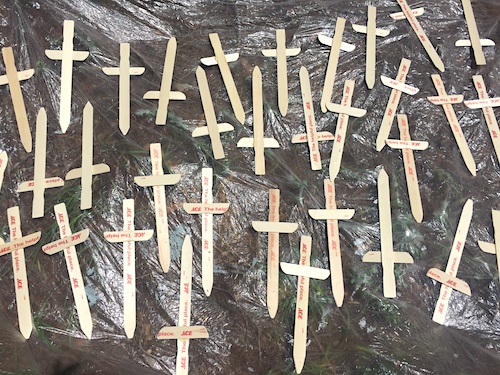
Using tin snips, trim a blunt point on half the number of stir-sticks, one per child.
Cut the remaining stir-sticks into 5 ½ -inch sections, then round the top corners.
Spray the trimmed pieces with silver paint on both sides.
Glue the hilt to the sword, allowing space on the handle for a child’s grip.
DIRECTIONS
Read the inspiration from Chapter 2 in the book, then show your inspiring model.
Give everyone a sword, then reveal your hoard of jewels and decorations and show them how to wrap the handle in leather. Remind the kids to use plenty of glue and give the jewels time to set.
Have them write their names in runes on the blade, using gold ink and the runes key (in our printables).
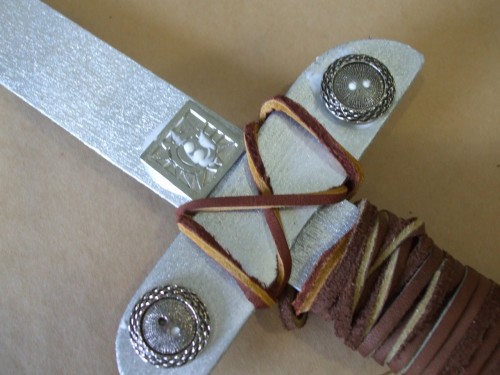
LitWits makes a small commission on supplies or books you buy through our Amazon affiliate links.
Creative Teaching Idea #5
Chapter 3
Who sees a rune or hears a riddle, and doesn’t try to figure it out? Tolkien knew puzzles were irresistible to readers—as they were to Gollum and Bilbo and Smaug. In this activity, kids get to write and decode their own.
When your kids hear they're going to combine runes AND riddles, they'll respond like you just promised them the Arkenstone! (In fact, you CAN, if you want to surprise them with these mini-Arkenstones afterward—since the runes do lead, with a thrush's help, to that treasure on Durin's Day!)
INSPIRATION
On midsummer’s eve, as the band of travelers prepares to leave Rivendell, Elrond asks to see their map. After holding it up to the light of the crescent moon, he discovers hidden moon-runes written beside the more obvious ones. He explains that since moon-letters can only be seen in the same light and season in which they were written, these letters must have been written on a mid-summer’s eve, under a crescent moon. (95; Ch. 3)
SUPPLIES
lemon juice
cotton swabs to write with
sealing wax and stamp (or ribbon, twine, leather strips, etc.)
an iron, if you want to reveal the answers in class
riddles (write your own, or use those included in our printables set - print as many as you need)
riddle answers, for reference (also included in our printables set)
runes key, one per child or show on a screen (use Tolkien's, or the handout included in our printables set)
DIRECTIONS
Cut the riddles apart on dotted lines and distribute one riddle and a runes key to each child.
Have each child decode their riddle using the key, and then write the answer (in runes), underneath his or her riddle, using a cotton swab dipped in lemon juice. Let dry. Refer to riddle answer key if needed.
Fold the papers and seal them closed with wax, then stamp. (Another option is to roll and tie them with leather, ribbon, or twine.) Have kids exchange these mysterious riddles with each other, and try to decode them.
When it’s time to reveal the answer, a hot iron will expose the magic runes.
LitWits makes a small commission on supplies or books you buy through our Amazon affiliate links.
Creative Teaching Idea #6
Chapter 5
J.R.R. Tolkien uses dialect to make Gollum very strange and yet entirely believable. In this writing activity, kids dissect his speech patterns, then get to rewrite ordinary boring sentences into Gollum-speak.
SETUP
Explalin that dialect is the way that people from a certain place or class of society talk. An author who writes dialect well can make characters seem unique and real.
DIRECTIONS
Read some of Gollum's dialogue (Chapter 5 has good examples) and discuss some of the ways his dialect is created. Then have the kids practice writing in dialect by translating modern sentences into Gollum-speak. You can come up with your own, or use the worksheet in our printables set, which not only breaks down Gollum's dialect but provides sentences for translation.
Creative Teaching Idea #7
Chapter 5
Gollum’s riddles lead to his discovery that his precioussss is missing from his pocketses! What else is in there, anyway? Aha—here's a great chance to get into a unique character's shoes, or rather, his pocket! Through this sensory activity, kids learn how Gollum's collection reveals his condition and character.
Have your kids reach into a cloth bag to feel the same objects Gollum collected and felt, and talk about what those objects might say about him. It's hard to do that and not feel the same understanding and compassion that BIlbo did.
SUPPLIES
For Gollum’s pocket you’ll need a rustic cloth bag (like a shoe bag, or a feed sack, or two dish towels stapled together and turned wrong side out!) that has these things in it:
fish bones – ideally a small but whole skeleton – ask the butcher! Or fishmonger! Snippets of white nylon fishing line or beading thread make good stand-ins for bones.
small shells that you’ve tossed in oil for a slimy feel
goblin teeth – you can get fake hillbilly teeth and use pliers to yank them from their fake gums while your spouse and children watch in rapt horror, but if you’re not quite as dedicated to authenticity as we are, then fine, just use broken pieces of chalk 😂
a sharp stone
a bat wing… forget any attempts at authenticity here! a Halloween prop or a piece of old leather will do, really!
DIRECTIONS
Tell the kids they’re going to hear a few riddles themselves (you’ll read them aloud), and if they guess the answer correctly, they get to feel and guess what’s in Gollum’s grimy pocketses! Tell them no peeking!
It’s so fun to watch their faces as they guess what those slimy things are! It adds a lot to play slightly creepy Middle-earthish music during this experience.
This activity pairs well with the "Write dialect in dialogue" activity. Kids love speaking like Gollum as they handle his meager, icky (but important) possessions.
FOR DISCUSSION
Gollum’s riddle game serves several purposes in this story. It shows us that Bilbo is getting increasingly clever; it lets us in on Gollum’s memories of his past and his grandmother; it increases the tension; and it entertains us in a new way.
But it also sets up the moment when Bilbo feels compassion for Gollum. Bilbo needed to get past him to escape from the cave, and could have easily have killed him, but didn’t. True, Bilbo realized it was not a fair fight since the hobbit was invisible, but he also saw Gollum as “miserable, alone, lost.”
Ask the kids to define compassion, which literally means “suffer with.” Then you might want to ask some of these questions:
What is it, exactly, that caused Bilbo to be filled with “a sudden understanding, a pity mixed with horror” when he had the chance to kill Gollum?
Who are some of the characters you felt sorry for in this story? Why?
Was there someone (or something) in particular that you felt you understood, deep in your heart, better than most people might? Who was that?
Bilbo gives us such a great reminder that we can understand and empathize without condoning. That in real life, we too can replace disgust with compassion, and judgment with mercy.
LitWits makes a small commission on supplies or books you buy through our Amazon affiliate links.
Creative Teaching Idea #8
Chapter 7
Kids love getting a taste of the story—especially if you choose a food that's either unfamiliar or important to a plot point or theme, or all three. In this activity, kids nosh on Beorn's fortifying feast of nuts, dried fruit, and twice-baked honeycakes.
INSPIRATION
This is what [Beorn] promised to do for them. He would provide ponies for each of them, and a horse for Gandalf, for their journey to the forest, and he would lade them with food to last them for weeks with care, and packed so as to be as easy as possible to carry – nuts, flour, sealed jars of dried fruits, and red earthenware pots of honey, and twice-baked cakes that would keep good a long time, and on a little of which they could march far. The making of these was one of his secrets; but honey was in them, as in most of his foods, and they were good to eat, though they made one thirsty…. —Ch. 7
SUPPLIES
There are many recipes online for Beorn’s secret-recipe cakes, or you can buy some that will stand in nicely.
You might want to fill a platter with dried peaches, apple and berry muffins from a grocery store, a pot of spun honey ( maybe even in a red earthenware pot, like Beorn's pots), and a mix of nuts and dried cranberries.
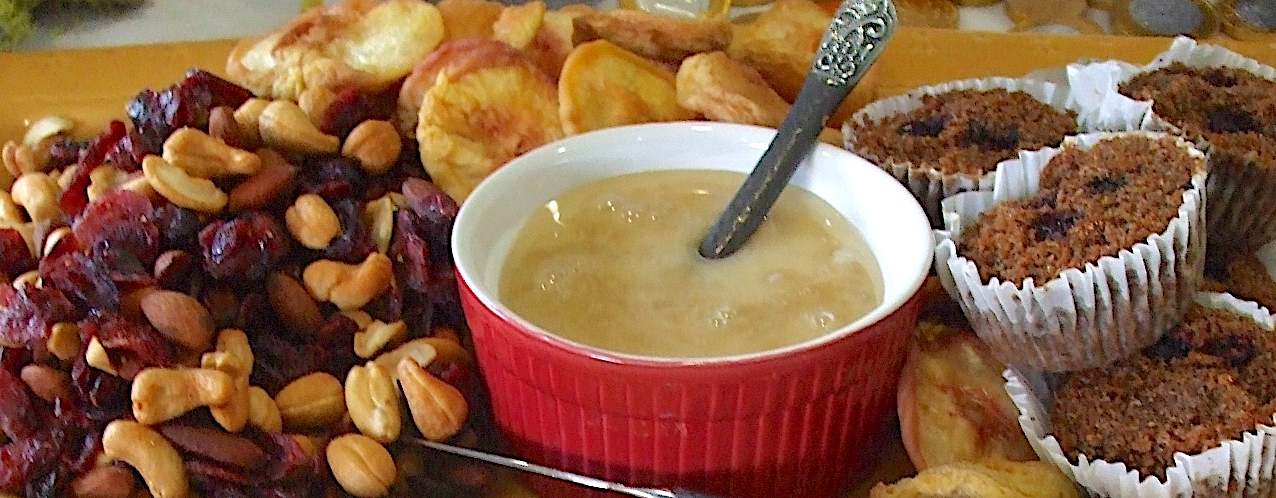
LitWits makes a small commission on supplies or books you buy through our Amazon affiliate links.
Creative Teaching Idea #9
Chapter 10
The Lonely Mountain, first seen from afar in Chapter 10 and then up close in Chapter 11, is the travelers' ultimate destination. But it's also an iconic symbol of J.R.R. Tolkien, who drew it himself. In this activity, kids get to be Tolkien the artist, while learning about that great man.
The inspiration for this art project is the dust jacket of the 1937 edition of The Hobbit, which Tolkien illustrated in his own inimitable style. The Lonely Mountain is at the center of the design, and Smaug circles ominously between the mountain and the moon.
SETUP
Before the kids begin to draw, show them the first three minutes (or more) of this video from the Bodleian Library at Oxford:
Then show them these illustrations of the Lonely Mountain by Tolkien:
(You might want to bring in this edition of The Hobbit that features more of Tolkien's own full-color illustrations.)
SUPPLIES
Any white rectangular paper
DIRECTIONS
Take a few moments to talk (or show this 6-minute how-to video) about the use of perspective, and about the signature way that Tolkien had of drawing snow-topped mountain peaks and dragons.
Have the kids copy the 1937 dust jacket. Because of the cost of printing, he had to reduce the number of colors he used to three, so tell the kids to do the same.
While they're drawing and coloring, you might want to share some more interesting points about Tolkien.
TALKING POINTS
The author's initials stand for John Ronald Reuel, and his last name is pronounced Tol-keen. Tolkien is German for “foolishly brave.”
Do you see a link between the author's last name and Bilbo’s ancestry? (Bilbo had some “Took” in him, which was the brave part of him that wanted to trade his walking stick for a sword. That sounds something like Tolkien! Also, Bilbo really was foolishly brave—especially in the beginning, e.g. his run-in with the trolls!)
The author’s parents moved from England to South Africa before he was born in 1892. He lived there until he was four, and during that time he had a bad experience with a large hairy spider.
Where does that experience as a toddler show up in The Hobbit? (In Bilbo’s battle with the spiders!)
When Tolkien was four, his father died of rheumatic fever. Little Ronald (as John Ronald was known) and his brother moved back to the West Midlands region of England, by Wales, with their mother. Little Ronald used to watch the trains from South Wales roar by, covered with Welsh place names: Nantyglo, Penrhiwceiber, Senghenydd.
What do those words make you think of?
Do those names sound like places where only boring things happen?
Do they sound modern?
These magical-sounding names had a great effect on Tolkien. He began to care about the way words and language sounded, and he began to dream of other worlds.
When their mother died of diabetes in 1904, the boys were left without parents or money. Fortunately they were helped by a priest, Father Morgan, who was half-Spanish and half-Welsh.
How might being left without parents or much money at 12 years old might show up in Bilbo Baggins many years later?
What does Bilbo really learn in this story? (He learns how to stand on his own two feet, to survive with very little but his wits, to learn from a wise older friend, to think for himself and do the right thing even when no one is watching — to keep going until he became all that he could be, on his own.)
Tolkien was already fluent in Latin and Greek at 12 years old, and was learning other modern and ancient languages.
How might Father Morgan’s Spanish and Welsh ancestry have influenced Tolkien? (It encouraged his interest in other languages, and increased his knowledge of Welsh.)
Tolkien went to war in 1916, but after four months he got “trench fever,” which is like typhus, and he was sent back to England. The illness came and went for two more years. While he was recovering, he wrote his first tales of elves and gnomes, using invented languages and worlds. But he needed a job.
What would be a dream job for a person who loves words and language? (How about . . . to work on a dictionary! He got that dream job as Assistant Lexicographer of the New English Dictionary – what we now call the Oxford English Dictionary.)
After that, Tolkien became a professor of languages, at Leeds and then at Oxford. There he was part of a literary group called the Inklings, along with C.S. Lewis.
One night while he was grading papers, he suddenly scribbled a strange line on someone’s essay, out of nowhere! The line began with “In a hole…” Let the kids guess the rest. Yes, “In a hole in the ground there lived a hobbit.”
And then Tolkien set out to learn just what a hobbit was, and why it lived in the ground. He told his kids stories about it, and that’s how The Hobbit came to be written!
Source: Adapted from The Tolkien Society
For more about J.R.R. Tolkien, see our "Meet the author" activity.
LitWits makes a small commission on supplies or books you buy through our Amazon affiliate links.

Creative Teaching Idea #10
Chapter 12
Bilbo starts his adventure full of fear, and ends it as a hero—because with Gandalf's help, he learns how much courage was in him all along. This activity helps kids understand Bilbo's character from the inside out, and see how important it is to give and gain confidence.
In Chapter 12, Bilbo takes on the traditional hero's role of slaying the dragon—or at least getting up the courage to try. Back in Chapter 1, we wouldn't have believed he'd ever do something so brave. But Bilbo has gained confidence and courage, along with compassion and other leadership skills, because of two things: experience, and Gandalf's unwavering belief in him.
DISCUSSION
Gandalf’s encouragement — including his “abandonment” of Bilbo in the woods — brings the hobbit to a point of self-respect. All along, Gandalf has known and expressed confidence in Bilbo’s courage. The hobbit himself lacked that confidence, but the courage was in him all along. In the end, as Thorin says, “There is more in you of good than you know, child of the kindly West. Some courage and some wisdom, blended in measure.”
How do Gandalf’s positive expectations affect Bilbo throughout the story? (Because Gandalf believes in him, Bilbo is willing to take chances and have adventures.)
Why in Middle-earth would Gandalf leave the group all alone in the woods with Bilbo? (Gandalf knew that not having someone to rely on would help Bilbo do things he never thought possible.)
What’s Bilbo’s turning point? (Bilbo’s fight with the spiders shows us — and him — that he’s not only braver than before, but more effective.)
How does Bilbo's behavior change over the course of the adventure, and why? (He steps up to make suggestions, offer assistance, and rescue his companions, approach a dragon, and betray friends for the greater good.)
Why don't people always do what’s right? What are they afraid of losing? Is being liked by someone else more important than liking yourself? (Talk about the courage it takes to cross your friends to do what’s right.)
DIRECTIONS
Ask one child to act out this part, exaggerating his or her expression of fear:
You're nine-year-old Fredia Kaht of Phobia City, and you're very, very afraid of the dark, and of spiders, snakes, and bears. You never go outside at night, and you sleep with all the lights on.
Now your dad wants to take you camping for a week! In a tent, without electricity! Beside the Snake River in Bear County! As you tell your best friend, "I can't, because ______________!!!"
Then ask the kids to be the best friend who expresses confidence in Fredia. You can offer one or more of these prompts if needed:
It’s okay, everyone has fears, it’s …
You can do it! Remember that time…
You can always do that trick where you…
Once when I was afraid you helped me by…
When you get scared, it’s okay to…
Your dad loves you, and he…
I know you’ll be…
Creative Teaching Idea #11
Chapter 8
If nothing had ever gone wrong in The Hobbit , it would have been a short, boring story that could have been told in a page or two. And Bilbo would never have risen to his potential! In this creative writing activity, kids get to make trouble for someone.
SETUP
Ask the kids when Bilbo begins to show signs of growth. It's that first (and failed) attempt to pick the troll's pocket that shows us he's willing to try something scary—that shows us he's got it in him to be braver someday. But in Chapter 8, in the forest of Mirkwood, he really steps up by solving the problem of crossing the river, and by rescuing himself and the dwarves from the spiders.
The point is, you can't grow without problems! Every problem is a chance to gain courage, confidence, and skills. And every good writer knows that!
DIRECTIONS
Write (or have a volunteer write) a short, boring scene and then have the kids brainstorm ways to make something—or lots of things—go terribly wrong.
Then have them rewrite the scene to give the main character some trouble, so s/he has a chance to GROW.
For some extra learning, create a word bank of vocabulary words from The Hobbit, give or discuss their definitions, and ask the kids to use at least six.
If you'd like some help with this, the creative writing worksheet in our printables set provides both the boring scene and the word bank, along with instructions.
Creative Teaching Idea #12
Chapter 19
Here's a hands-on, fun, sensory way to mark your way through the narrative arc, Bilbo's character growth, and the terrain of Middle-earth, all at once! This activity helps kids "track" all three topics in sensory ways, and delivers a motivating treasure at the end.
Kids love doing something during a discussion, especially something that makes the discussion points real. This interactive project simultaneously covers plot points, setting, and character development — and reveals the theme. All while the kids are having a wonderful time!
Here's the premise: as you discuss each plot point, place, and event that pushed Bilbo to grow, have the kids mark that trio on the arc-map with a special symbol. There’s a little prep involved, but it’s not hard. It'll end up looking like this:
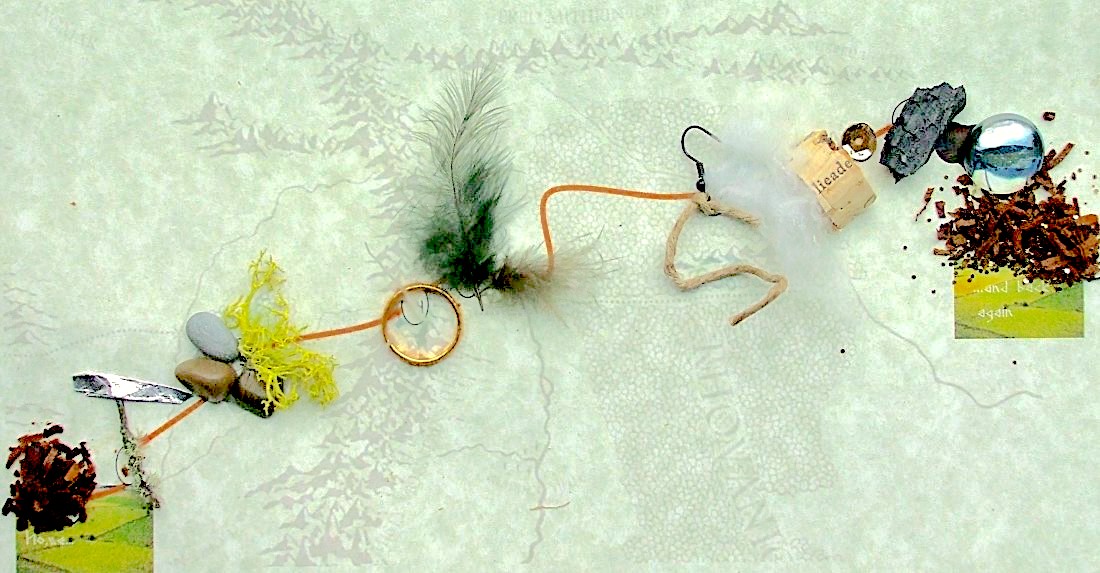
You could do this project throughout the reading of the book, or at the end.
SUPPLIES for each child (in order of distribution):
1 bottle of glue (or enough to share)
1 pinch coffee grounds or darkly toasted coconut
1 thin twig about 1 1/2” long
1 tiny twist of aluminum foil, about 1” long
1 pinch moss
3 small pebbles
2-3 fish bones – see supply notes for "Explore Gollum’s Grimy Pocketses" activity
1 short piece of twine knotted on black earring hooks (you can clip the ends of the hooks with wire clippers so they look less like earrings)
1 pinch artificial spiderweb (a good prop for this lesson, too) or a wisp torn from a cotton ball
1 small cork, cut in half, or rough-cut pieces of wine corks
1 large gold sequin
1 tiny chunk of charcoal from a barbecue pit or fireplace
1 clear bead with a flat side (also used in "Forge an Elvish Sword" activity)
1 pinch coffee grounds or toasted coconut mixed with gold glitter
1 arc-map template printed on parchment and matted on cardstock (included in our printables set)
1 scenes key handout (included in our printables set)
DIRECTIONS
Begin by distributing the arc-map and the scenes list, and explaining the concept of the narrative arc. (The script is included in our printables set)
Next, explain that as we discuss the arc of The Hobbit we’re also going to talk about how each event helped Bilbo to grow. In the places where he gets stronger and better, they're going to add a token of his growth. So they'll end up with a chart of his growth, his journey, AND the arc of this story!
We're giving you a quick overview below, so you know "what goes where." An in-depth, 6-page script with teaching points is included our printables set, to help you share valuable lessons as you work through the arc.
And off we go!
Exposition (#1): To represent this peaceful, stay-at-home stage of Bilbo's life we’ll use coffee grounds. Bilbo and the dwarves smoked pipes, but we can imagine them drinking hot mugs of Misty Mountain Roast as they planned their journey. Put a blob of glue on your arc, on the number 1. (We used toasted coconut as "tobacco," but coffee grounds carry the same message and are less appealing, and that's a good thing.)
Conflict (#2): We’ll use a sword and a walking stick to make the letter “T” for Took, to show Bilbo’s conflict between his stay-at-home side and his Took side. We’ll put the sword across the top to show that the Took side won. Put a blob of glue on #2 on your arc, still in the Shire. (Pass out the twigs first, and then the twisted bits of foil.)
Rising Action (#3): A bit of moss represents the bush where Bilbo got stuck, and three pebbles to represent the fossilized trolls. The moss and pebbles will show that Bilbo at least made an effort, but that he didn’t get very far, and had to be rescued. Put a big blob of glue on #3, by the trolls. (Pass out the pebbles and pieces of moss.)
(#4) A ring and a couple of fish bones represent the important things that happened in the goblin cave. The ring isn’t just something Bilbo found – it’s a source of power for him, and it gives him a tool for escape. And the bones don’t just represent Gollum’s diet, they represent the fact that Bilbo is starting to get some backbone! A spine! He did things that took “strength and resolve,” like leaping over Gollum and getting away. Put a blob of glue on #4, in the Misty Mountains. Set the bones first, then add more glue on top, and then the ring. (Hand out the bones in the first round, then the rings.)
(#5) A feather or two represents Bilbo soaring to new heights – but not with his own wings, so to speak. He’ll get there, though! Put a blob of glue on #5, near the eagle eyrie, east – that’s to the right – of the Misty Mountains, and west – that’s to the left – of the Great River. (Give a feather to each child.)
(#6) We’ll use our own little “rope and hook” to represent Bilbo’s sharp vision and wits. Put a blob of glue on #6 in the Mirkwood Forest, right there where the Elf-path crosses the Enchanted River. (Pass out the twine and hooks.)
(#7) A wisp of spiderweb represents that moment of crisis and Bilbo’s newfound bravery. Put a blob of glue on #7, just to the right of the rope and hook, where the spiders are. (Pass out the shredded bits of faux spiderweb.)
(#8) A piece of cork represents Bilbo’s planning skills and the wine barrels they used to escape. If your piece is a broken chunk, let that stand for the imperfection in his plan! Put a blob of glue on #8, on the Elvenking’s Hall. (Pass out the corks, or pieces of cork).
(#9) A "gold plate" represents Bilbo’s transformation from boring and fearful to adventuresome and brave. Put a blob of glue on #9. (Pass out the gold sequins.)
(#10) Charcoal represents the burning of Lake-town and the heroic role that Bilbo had in Smaug’s death. Put a blob of glue on #10, by Esgaroth. (Pass out the bits of charcoal.)
Climax (#11) We’ll use a drop of goblin blood on #11 to symbolize the terrible events that Bilbo (mostly) missed, and how they helped him decide what really matters. (Walk around with the vial of “blood” from the display table, and let the kids use a paintbrush to get their own drop. Somehow the act of reaching into the vial greatly adds to the ick factor!)
Resolution (#12): We’ll use a miniature Arkenstone to symbolize the point when Bilbo hands it over, and gives up most of the treasure he had earned, because it was the quest and the friendships that mattered – not the loot. Put a blob of glue on #12. (Pass out the flat-sided crystals.)
Falling Action (#13): Let’s use a pinch of coffee mixed with gold to symbolize Bilbo’s journey home, because now he’s even richer on the inside. Put a blob of glue on #13, which represents the return trip to the Shire, where the journey and book both end. (Pass around the coffee grounds or whatever you’re using for “tobacco,” mixed with glitter, and put a pinch on every blob.)
We’ve traveled through the whole plot of the story, and have “seen” the terrain between the Shire and the battlefield. Most importantly, we’ve tracked Bilbo’s personal progress through that plot and across that terrain. And what thematic treasure did we find during that three-layered climb?
Everyone has the ability to rise to their own potential!
(Once the glue has dried, have the kids glue the scenes key on the other side.)
Again, if you'd like the full script for this activity, you'll find that in our printables set.
LitWits makes a small commission on supplies or books you buy through our Amazon affiliate links.
Creative Teaching Idea #13
You've just taken your kids on a field trip through The Hobbit ! This travel sticker will always remind them of a pivotal turning point in Bilbo's character growth, not to mention a tremendously exciting scene, and one of Tolkien's most memorable settings.
Give the kids the souvenir travel sticker included in our printables set, or have them design their own.
Kids might like to add their sticker to a reading kit, like an old briefcase (or faux vintage) or a suitcase that can hold a book, bookmark, glasses, snack, blanket, journal, pen, and whatever! Or they might want to put it on a binder or water bottle.
No matter where they see their sticker later, it will remind them of this wonderful journey they've taken with you!
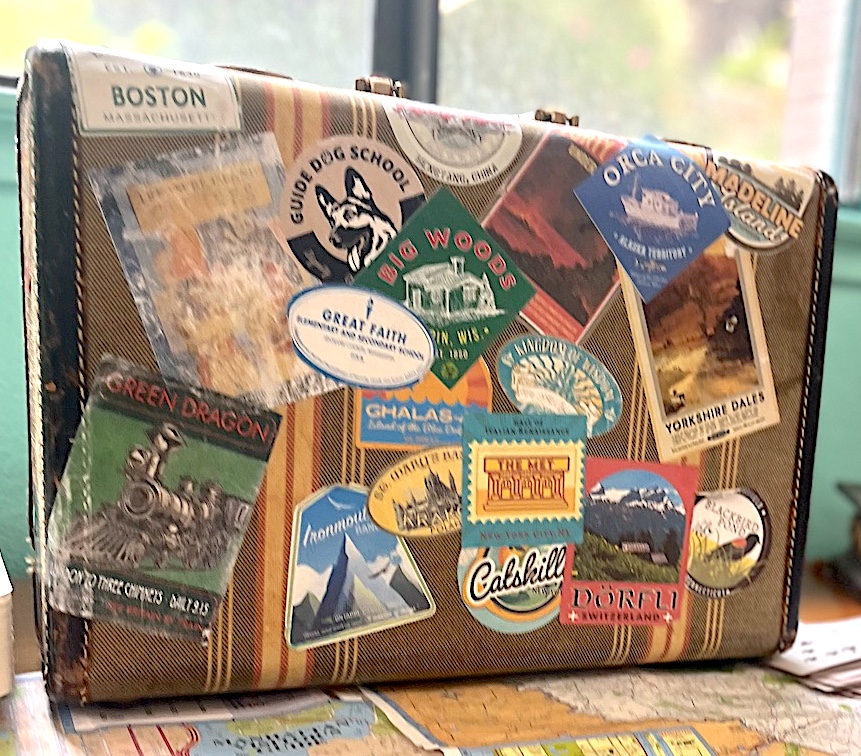
LitWits makes a small commission on supplies or books you buy through our Amazon affiliate links.
Some of our activity ideas need printables or worksheets. Don't spend hours coming up with your own!
for teaching The Hobbit by J.R.R. Tolkien
Borrow or buy the book, if you don't already have it. You can also listen to an audio version, dramatized wonderfully by the BBC. Reading on a screen should be a last resort. The sensory feel of the pages in your hand, or the sound of someone reading to you, is the first important step in sinking into the sensory experience of this story.
The Hobbit is best for ages 9-12. (You can read reviews on Amazon). Here's our short summary of the story:
Bilbo Baggins is a sedate, boring little hobbit who enjoys a comfortable stay-at-home life in the Shire. But when the wizard Gandalf and a company of dwarves arrive, life becomes a tremendous adventure. Against his will (at first) he accompanies them on a journey to raid a dragon’s treasure hoard inside Lonely Mountain. As they travel, Bilbo runs into frightening creatures and finds a magic ring that saves his life. With every challenge he grows, and soon he’s saving the lives of the dwarves, and finding out just what he’s made of: courage, intelligence, and loyalty. The Hobbit is an exciting, beautiful adventure through Middle Earth, to grasp the real treasure of potential.
LitWits makes a small commission on supplies or books you buy through our Amazon affiliate links.
You can have them read or listen to it on their own, or you can enjoy it together as a class. Most importantly, read only for fun! Tell the kids to simply enjoy the book, without any assignments in mind. It's hard to get caught up in a story if you're supposed to be looking for something that takes you out of it.

It's helpful to know The Hobbit 's big teaching points ahead of time, and explore some fascinating links to add to your lessons. We already found those for you, so you too could enjoy reading the book without an assignment in mind. :) Our teaching ideas connect to these takeaway topics:
Encouraging Courage
In the beginning, when Gandalf tells Bilbo he’s a great burglar (or will be), neither Bilbo nor we can believe it. He has a lot of false starts and has to work hard to earn the respect of the dwarves--and himself. But by the end of the story, he's discovered, as have we, that he had what it took (ah, in his ancestral Took side!) all along. What a beautiful lesson for kids and adults, taught through a page-turning, empathy-building adventure!
Modeling Compassion
Compassion drives every good act in The Hobbit: Gandalf’s nomination of Bilbo as burglar, the hobbit's decision to spare Gollum, Bilbo’s betrayal of the dwarves to help end the battle, and many more. It's a life-changer to learn that to be compassionate is to understand--not necessarily to agree or approve, but to choose one's own actions after "getting it."
J.R.R. Tolkien
As in any book, there are many events, characteristics, and ideas in the story that relate to its author’s life. Finding those connections helps us understand why the characters do what they do, and what they're supposed to learn by doing them. Which is why we have kids learn those same lessons by doing those same things!
Additional topics
You might also want to explore the supportive Learning Links at the end of this page, especially if you have older or more advanced kids. Make notes as you go, so you’ll remember what you want to share, and when.

Once you've read The Hobbit and have a feel for its big ideas, decide which activities to do. Don't feel you need to do them all! Choose one or two or whatever you think will best suit you and your kids. Having said that, here's a sample agenda for a 3-hour "field trip" through a great book.
This sample agenda can be followed in part or in whole, all at once or over weeks—whatever works for you.
Set the tone. Ask the kids how this book made them feel, and why, and what it made them want to do. Point out that the author intended to make readers feel, think, and act—that literature is never just entertainment.
Introduce the author. Next, introduce the author through the biography video provided, to pay tribute to the story’s creator and recognize how his/her life story shows up in the book.
Introduce the arc. Give a brief overview of the concept of the narrative arc (here's our explanation for kids). Assure the kids you'll go through it in detail together.
Find the setting. Get your bearings before you set off! Explore the setting through audiovisual aids, and talk about any setting-specific props,
GET HANDS-ON ! Do the activities you've chosen (we do them in story order, for the most part, but do whatever holds your kids' interest.) Talk about the meaning(s) embedded in each project. Pass around props at relevant points to give the kids a tactile, sensory engagement with a significant item, including food and sounds. Look for moments to pop in an audiovisual—hear that medieval chant! watch that Friesland horse run!
Worksheets: If you're using our worksheets, we suggest weaving them in between activities, to keep the writing light and energy high. This woven blend of doing, talking, and writing is what helps lessons stick, and makes this book more meaningful and memorable for your kids.
Timing: This means you're doing a new activity every 10-20 minutes, so things move quickly and the energy stays high. Of course, if your kids would benefit from a slower pace, by all means take your time. The point is to keep everyone relaxed and having fun—so they're better able to learn. Do whatever best serves your teaching needs, in the order and at the pace that keeps your kids respectfully, happily engaged.
WRAP IT UP! Once you've gone through the narrative arc, reward everyone with a souvenir travel sticker—you can have the kids make one, or give them the one included in our printables set. It's just a fun way of proving they've been "there and back again."
Gather or buy your supplies. You can right-click anywhere on this page to print lists and instructions, if you'd like a hard copy—you'll need to open up the "Read more" drop-downs first.
Do the activity prep you'd rather handle yourself than have your kids do; this will depend on your time, kids' ages and abilities (and how important it is to you that the finished project looks as intended!).
Print the printables you're using, whether you made them or bought our set. Which brings us to . . .
Don't spend hours creating worksheets and printables to use with our activity ideas. We've already made those for you!
Buy our full set, for just about nothing.
Be sure to let us know how it goes! In fact, if your kids have a blast with The Hobbit, we'd love your help spreading the word about our resources for teaching children's literature.
Tag and follow us on Instagram, YouTube, Facebook, and Pinterest—and please leave a review!
for teaching The Hobbit by J.R.R. Tolkien
Aw, you’re just the right age, whatever that might be! Just kidding—we know what you mean. We find that 8-12-year-olds are consistently “ready to LitWit.” Generally speaking, their reading level is high enough to take on the vocabulary and syntax of literature, and they’ve acquired enough knowledge to grasp new ideas. Yet they’re still full of wonder, and are highly responsive to the “check this out!” nature of sensory immersion.
However, we often have mature kids of 6-7 in our experiential workshops, and sometimes fun-loving kids of 13-14. As a teacher or parent, you know best what your kids are ready for and interested in.
Yes. Our methods and ideas are adaptable to a wide range of abilities—kids particpate at their own level. The point isn't to come up with a stellar work of art or a perfectly polished project, but to have the experience of doing something the characters did, or a spin on it. After all, those characters were of mixed abilities, too!
This is true of mixed levels of enthusiasm as well. Kids who already love reading are thrilled to get the chance to extend the story, and kids who don't yet believe that stories are fun end up wanting to read (or listen to) more great books.
LitWitting is a flexible, fun way to teach, adaptable to all ages and abilities, so there isn't "one way to do it" —every educator's circumstances and children are different. Having said that, we suggest you follow the narrative arc, and we've provided an example of a simple plan above, under Prep Tips.
But the truth is, if you and your kids are having fun, and when it's over they want more (which means reading another great book), you’re doing it right!
Absolutely—but when you're finished, they'll probably ask if there's something else you can do, or have a suggestion of their own! And that's GREAT! It shows they're liking this kind of learning, and seeing that books can be experiences for them too, not just for the people in the story.
Get your feet wet with a project you think they'll like best, never mind how deep and meaningful it is—even if they're "over" this book, if they know you'll be LitWitting other books, they'll want to read them!
In our workshops, the very most reluctant readers are the ones who, when their mom comes to pick them up, are tugging at her sleeve and saying "sign me up for the next book they're doing!" (We love that they always say "doing!").
They're right here on this page! Just click the "Read more" under each activity for all the details.
You can right-click to print this page, if you'd like a hard copy—be sure to open all the drop-downs first, so the hidden contents will print too.
We keep all this info online so we can include helpful links, make updates in real time, add new ideas, and let you use our materials on a screen.
Sure you can, for your noncommercial use in your family, classroom, library, book club, or wherever! As long as you’re not calling your fun time a “LitWits” event or charging a fee, you can use our ideas and printables to do lots of wonderful things!
Please don’t forward your printables or make copies for people who haven’t paid for them, of course, out of courtesy and to honor our copyright, and per our Terms of Service.
Did you find what you were looking for? Do you still have a question? Are you feeling inspired, but maybe also somewhat overwhelmed? Never fear—we're glad to help! You're literally on our page about inspiring kids to read more, and we'd love to support you as you change the world, one book at a time.
Happy teaching,
Becky and Jenny
Sisters, best friends, and partners
for teaching The Hobbit by J.R.R. Tolkien
Like all children's literature, this book is chock-full of many subjects to explore—from archetypal heroes and villains to Norse mythology and crosscultural friendships. Browse these curated links to supplement your reading experience, research points of interest, and prompt tangential learning opportunities.
Story Supplements
Maps of Middle Earth:
Map of Middle Earth (downloadable) by Christopher Guerette)
Maps of Middle Earth (Google search results)
Images of Tolkien’s Lonely Mountain
Dust jacket by Tolkien
“The Front Gate," by Tolkien
Newly discovered Tolkien illustrations (The Guardian)
"Smaug settles on the Lonely Mountain in a spout of flame" (TolkienBooks)
Images and sounds of things and creatures in the book – see our Pinterest board for more!
Medieval pipes (for purchase)
Smoke rings
A plant that smells like the trolls’ lair!
Bilbo's seed cake and recipe
Sounds of a forest – listen to free sample or buy album
Video with forest sounds
Video of the wind blowing through a pine forest
Sound of a waterfall (video)
Sound of a screech-owl
Sound of a barn owl
English thyme
Sharp mountains in moonlight
Eagle in flight by high mountains (expand!)
Video of hissing steam vents (sounds like Smaug's breath on the water)
Images of hauberck/mail shirt, mattock, round shield
Music
Wonderful music inspired by The Hobbit (Middle Earth orchestra)
or access the video for free, with scenic Middle Earth backround
The soundtrack to The Hobbit: An Unexpected Journey - album for purchase
“May it Be” by Enya, from the soundtrack to The Fellowship of the Ring
or access the video for free, with movie images
“Lothlórien” by Enya, on her Shepherd Moons album - on YouTube
Video (band logos are the only images) of dark, spooky music in “Orkish” by the band Za Frumi
Video/lyrics of “The King Beneath the Mountains,” sung upon the dwarves’ return to Lake-town - on YouTube
Hobbit home recreations
Full-size hobbit home recreated in New Zealand
Amazing 3-D miniature of the hobbit hole, by talented Madeline Chambers/Brindley
About the Book & Author
Book covers of various editions
Tolkien’s “hobbit” entry for the OED
How the book came to be (The Arcanist)
Audio interview with Tolkien, 1965 - BBC Radio via 40-minute video
Summary and review from GoodReads
"Who was Tolkien?" biographical sketch - The Tolkien Society
Official site of the Tolkien Estate - family photos and much more
Brief biography - American Society of Authors and Writers
Photo of Tolkien as a young man - Wikipedia
Image of Tolkien in 1916, in uniform - Wikimedia
Image of Tolkien’s wife, Edith
Extremely long Welsh word like those that inspired young Tolkien
Tolkien special collection at Marquette University library
Tolkien illustrated bibliography
"When Things Get Hairy, Be the Hobbit" - LitWits blog post
Beyond the Book
Top-quality “Hobbit” collectibles - for purchase
Discover your hobbit name with this elf/hobbit name translator!
Rune converter/generator - "Read for fun" = ᚱᛠᛞ ᚠᚩᚱ ᚠᚢᚾ
Advanced information about Tolkien’s runes
Large raven hand puppet - for purchase
Information from The Metropolitan Museum about medieval armor